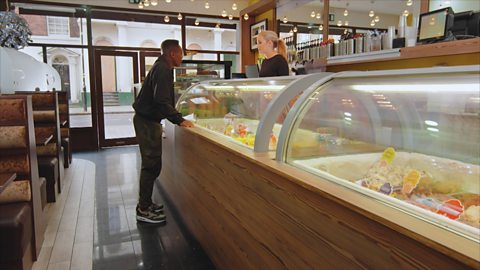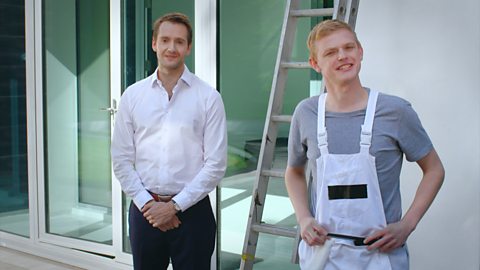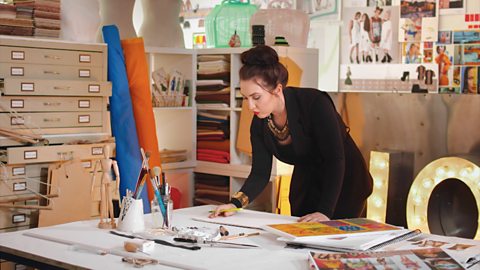CUSTOMER:I think I'm in love!
SALESMAN:Hello there, sir.
SALESMAN:Do you need any help?
CUSTOMER:Uh, yes… Mate. Um… I have to have this car.
SALESMAN:Great! Will you be looking at paying cash or finance?
CUSTOMER:Finance.
SALESMAN:Well, we do offer a finance program with a three year term, and an interest rate of 5%.
CUSTOMER:'So how much will I be paying over the three year term? Now the car is £28,000,
CUSTOMER:'and I need to subtract my deposit of £3,000. So the value of the loan is £25,000. To calculate the total repayable amount, I need to use a multiplier, and the equation, P multiplied by one plus R, to the power of N,
CUSTOMER:'where P is equal to the original value,
CUSTOMER:'here it is the price of £25,000, R, which is equal to the rate, 'here it is the interest rate of 5% APR which, divided by 100, gives me 0.05. And N, which is equal to the duration of time. Here, the number of years. So 25,000 multiplied by 1.05, which is my multiplier,
CUSTOMER:'to the power of three, equals 28,940.625.
CUSTOMER:'And if I divide this by 36, which is the number of months the term covers, my monthly payment will be £803 and 91 pence. Plus, taking into account my original deposit of £3,000,
CUSTOMER:'the total payment I will have made over the three year term will be £31,940 and 63 pence.'
SALESMAN:Sir?
CUSTOMER:Will the car hold its value over the three years?
SALESMAN:On average, it will depreciate by approximately 8% each year.
CUSTOMER:'So using the same equation, I can calculate what the value of the car will be in three years' time. However, as this is a decrease, rather than adding the rate, I need to subtract.
CUSTOMER:'So P multiplied by one minus R, to the power of N. where P is equal to the original value,
CUSTOMER:'here it is the price of the car, not the loan, which is £28,000. R is equal to the rate of depreciation, which is 8%,
CUSTOMER:'and divided by 100 gives me 0.08. And N is equal to the duration of time. Again, this is three years.
CUSTOMER:'So 28,000 multiplied by 0.92, which is my multiplier, to the power of three. Which equals 21,803.264.
CUSTOMER:'So after three years, I will have paid £31,940 and 63 pence.
CUSTOMER:'And the car will be worth approximately £21,803 and 26 pence.'
SALESMAN:Great, sir. You've made the right choice. For now.
Video summary
A good example of how complex calculations are relevant in everyday life.
A man wishes to buy a car on finance over three years.
He uses a formula to calculate his monthly payments at 5% interest, and the total he would pay over the three years.
On learning a car depreciates in value by around 8% a year, he calculates the value of the car by the end of his finance deal.
The calculations are shown in graphics on the screen.
The man discovers his payments would be around £800 a month and the car would depreciate in value by around a third, and makes the sensible decision to choose a less expensive car.
This is from the series: Real Life Maths.
Teacher Notes
Students could investigate their own affordability and budget; regarding different mobile packages or any other financial situations.
This could also be used to research in science, medicine and other situations where growth or decay can be measured over time.
Financial planning and investment can be based on “Problem based learning” and students could make inference and decisions about buying a car, financial growth in a company and loss of investment over time.
Students could use this opportunity to look at stocks and shares as part of project based work.
This clip will be relevant for teaching Maths at KS3/GCSE in England Wales and Northern Ireland. Also at National 4, 5 and Higher in Scotland.
This topic appears in OCR, Edexcel, AQA, WJEC in England and Wales, CCEA GCSE in Northern Ireland and SQA in Scotland.
Ratio and Proportion. video
A cake company demonstrates how ratios and proportions are used to complete an order.

Percentages. video
Clothes shopping and video statistics are used to explain percentages.

Algebra. video
A mobile phone deal and a trip to the cinema are used to explain algebra.

Sequences. video
The purchasing of cupcakes is used to explain linear and quadratic sequences.

Probability. video
Predicting the weather and choosing a chocolate are used to explain probability.

Pythagoras. video
Cleaning a window and installing a TV are used to explain the theory of Pythagoras.

Trigonometry. video
A hiker trying to work out the height and distance he's walked uses trigonometry.

Fractions. video
A group of friends sharing a meal is used to explain fractions.

Geometry. video
A clothes designer trying to make an outfit uses geometry.
